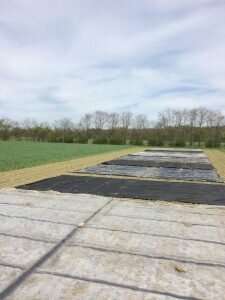Tarp use on small Northeast farms

A new University of Maine Cooperative Extension publication, "Tarping in the Northeast: A Guide for Small Farms," provides the most up-to-date information on an emerging practice of tarping—applying reusable tarps to the soil surface between crops and then removing them prior to planting—for weed and soil management. Intended for beginning and experienced farmers, and based on research and farmer experience, the guide highlights successful tarping practices, as well as situations to avoid.
Topics include basic information on how and why tarps work in the field; a range of management practices, from weed seed depletion to tillage reduction; and case studies of six farmers currently using tarps.
This guide is the result of a Tarping and Soil Solarization working group project initiated by UMaine researcher and Wilson Center director Sonja Birthisel, who did her dissertation on ecological weed management, including the effects of tarping and solarizing on weed dynamics.
With colleagues, she successfully applied for a working group grant through the Northeast IPM Center at Cornell University to gather resources, identify knowledge gaps and discuss future research. Birthisel also formed a working group of Extension professionals, farmers who were expanding their use of tarping and researchers from six Northeast states who were investigating aspects of tarping.
"My goal in forming this working group was simply to establish channels of communication, so we could coordinate research and outreach across the Northeast, and make sure we weren't all re-inventing the same wheel. I was really excited to put together a team of people with different kinds of expertise—farmers, Extension staff and researchers with specialties in a range of areas, from weed management to entomology to soil microbiology—so we could take a really comprehensive look at tarping practices from multiple viewpoints and all learn together," says Birthisel.
The production of the guide took form over 18 months, led by University of New Hampshire Agroecology Laboratory postdoctoral research associate, then graduate student, Natalie Lounsbury; UMaine Extension sustainable agriculture professional Jason Lilley; Cornell Small Farm Program Extension specialist Ryan Maher; and Birthisel.
"This research group worked with farmers who pioneered using tarps to enhance their vegetable production systems and soil health. The guide includes those farmers' practical setbacks and successes, and research-based data to highlight both why this system works and how to make it work. Farmers who are newly adopting the practice will be able to draw on this resource to ensure increased success sooner," says Lilley.
More information: Bulletin #1075, Tarping in the Northeast: A Guide for Small Farms. extension.umaine.edu/publicati … /Photo-G0-banner.jpg
Provided by University of Maine




















